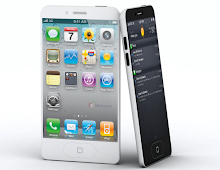iPhone 4: Everything You Need to Know
The iPhone 4 is here and I have all the answers to your questions about Apple's new iPhone including pictures and detailed specifications.
 Steve Jobs introduced the iPhone 4 today, which he claims offers over 100 new features, though he would focus on only a handful for the keynote. The iPhone 4 looks like the iPhone prototype obtained under questionable circumstances by Gizmodo: stainless steel casing, all-glass front, and a design Jobs describes as the thinnest smartphone on the planet: almost 25 percent thinner than the iPhone 3GS.. Unlike previous iPhones, the iPhone 4 will have volume controls on the side of the phone along with an accessible microSIM tray. The iPhone 4 features a front-facing camera, and the back sports a microphone, 30pin connector for docking, and a speaker, while the top sports a second microphone for noise cancellation, sleep/wake button, and a headset input.
Steve Jobs introduced the iPhone 4 today, which he claims offers over 100 new features, though he would focus on only a handful for the keynote. The iPhone 4 looks like the iPhone prototype obtained under questionable circumstances by Gizmodo: stainless steel casing, all-glass front, and a design Jobs describes as the thinnest smartphone on the planet: almost 25 percent thinner than the iPhone 3GS.. Unlike previous iPhones, the iPhone 4 will have volume controls on the side of the phone along with an accessible microSIM tray. The iPhone 4 features a front-facing camera, and the back sports a microphone, 30pin connector for docking, and a speaker, while the top sports a second microphone for noise cancellation, sleep/wake button, and a headset input.Jobs went on to highlight the bands around the side of the iPhone 4 that caused much speculation in the wake of the leaked prototypes. Jobs identified them as part of the phone’s antenna system, saying the stainless steel band is also a primarily structural element of the device. The antenna supports all the iPhone 4’s wireless capability, from 3G to Wi-Fi to Bluetooth to GPS along with cellular communications.
iPhone 4: Retina Display
The iPhone 4 will also sport what Jobs described as a “retina display” with four times the pixel density of a typical LCD display at a whopping 326 pixels per inch—by far denser than anything else in the consumer electronics market. The result is a 3.5-inch display with a native resolution of 960 by 640 pixels that is actually a higher resolution than the typical human eye is capable of perceiving, when held at a distance of just 10 to 12 inches. Jobs claims the iPhone 4’s display winds up looking like a high quality printed book (albeit that emits light!) rather than a blocky pixellated grid. The iPhone OS automatically handles rendering text and controls at the higher resolution for the iPhone 4, so developers don’t need to do anything to update their applications to look good on the new display…but, of course, if developers want to add higher-resolution graphics to their apps, they will look stunning on the iPhone 4.
iPhone 4: A4 Chip and Gyroscope
The iPhone 4 will also feature an Apple-designed A4 CPU, following along the lines of the processor powering the iPad. Jobs said the A4 processor improved power management, so the iPhone 4 will manage 40 percent more talk time on 3G networks (up to 7 hours), or up to 6 hours of 3G Web browsing or 10 hours of Wi-Fi browsing. The device can also play up to 10 hours of video, 40 hours of music, and should have an standby time of up to 300 hours. The iPhone 4 will also pack up to 32 GB of onboard flash storage, and will offer quad-band HSDPA/HSUPA for mobile broadband speeds up to 7.2Mbps downstream, 4.8Mbps upstream…assuming carrier networks support that technology. The iPhone 4 will also support 802.11n Wi-Fi, assisted GPS, Bluetooth, and packs and accelerometer, compass, proximity sensor, and an ambient light sensor,. The iPhone 4 also sports a gyroscope, which enables six-axis motion sensing…just like a game controller, and iPhone OS 4 will offer developer APIs to leverage the gyroscope: Jobs envisions the gyroscope enabling whole new types of mobile gaming.
 8:02 PM
8:02 PM
 PECH PHEARUN
PECH PHEARUN



 Posted in:
Posted in: 








0 comments:
Post a Comment